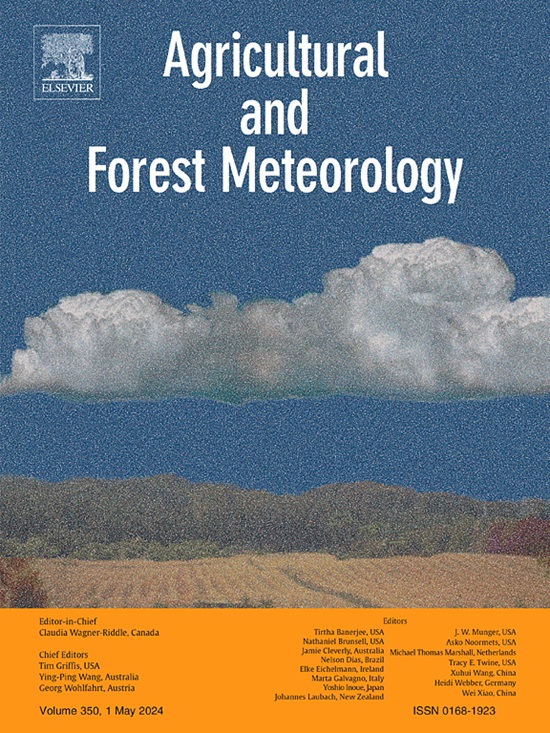Analysis of scale-dependent spatial correlations of actual evapotranspiration measured by lysimeters
IF 5.6
1区 农林科学
Q1 AGRONOMY
引用次数: 0
Abstract
Accurate determination of actual evapotranspiration (ETa) is important in various research fields like hydrology, meteorology, ecology and agriculture. In situ ETa can be determined using weighing lysimeters and eddy covariance. However, despite being regarded as the most precise in situ method for measuring ETa, the information content of lysimeter measurements remains poorly understood. Here we examined the spatial correlations between ETa measured at different locations by lysimeter (ET-LYS) and at different locations by eddy covariance (ET-EC). This was done for the period 2015 - 2020 and the analysis was made for different spatial (range: 0 to 500 km) and temporal scales (range: 1 day to 1 year) using 23 lysimeters and 4 eddy covariance towers. We found that: (a) Same lysimeters at the plot scale show very high correlations of ET-LYS; (b) The Pearson correlation of daily standardized anomalies of ET-LYS between sites exhibit moderate to high correlations and were similar to that of ET-EC, indicating that lysimeter is generally as representative as EC regarding ETa, and can provide certain information at the landscape and larger regional scale. During winter, the spatial correlations for ET-LYS were smaller; (c) Wavelet analysis indicated that temporal correlations in ETa were strongest for distances in time around 12 months (yearly cycle) and less than three months. Spatial correlations were smaller under drought conditions (in the year 2018). Furthermore, combination of multiple ET-LYS from different sites improved the predictability of ET-LYS for another site, suggesting that ET-LYS can be predicted well using ET-LYS from different neighboring sites. Overall, lysimeter measurements can provide information at much larger scales compared to their small measurement area.
分析莱西米测量的实际蒸散量与尺度的空间相关性
准确测定实际蒸散量(ETa)对水文学、气象学、生态学和农业等多个研究领域都非常重要。原位蒸散发可以通过称重式蒸发仪和涡协方差法测定。然而,尽管赖氏仪被认为是测量蒸散发的最精确的现场方法,但人们对赖氏仪测量的信息含量仍然知之甚少。在此,我们研究了在不同地点用赖氏仪测量的蒸散发(ET-LYS)与在不同地点用涡度协方差测量的蒸散发(ET-EC)之间的空间相关性。这项研究是在 2015-2020 年期间进行的,利用 23 个赖氏仪和 4 个涡度协方差塔对不同的空间尺度(范围:0 至 500 公里)和时间尺度(范围:1 天至 1 年)进行了分析。我们发现(a) 在地块尺度上,相同溶样仪的 ET-LYS 相关性非常高;(b) 各站点间 ET-LYS 日标准化异常值的皮尔逊相关性为中等至高等相关性,与 ET-EC 的相关性相似,这表明溶样仪在 ETa 方面与 EC 具有同样的代表性,可以在地貌和更大的区域尺度上提供一定的信息。在冬季,ET-LYS 的空间相关性较小;(c)小波分析表明,ETa 的时间相关性在 12 个月(年周期)和 3 个月以内的时间距离最强。在干旱条件下(2018 年),空间相关性较小。此外,将不同站点的多个 ET-LYS 结合在一起可提高另一站点 ET-LYS 的可预测性,这表明利用不同邻近站点的 ET-LYS 可以很好地预测 ET-LYS。总体而言,相对于较小的测量区域,溶液计测量可提供更大范围的信息。
本文章由计算机程序翻译,如有差异,请以英文原文为准。
求助全文
约1分钟内获得全文
求助全文
来源期刊
CiteScore
10.30
自引率
9.70%
发文量
415
审稿时长
69 days
期刊介绍:
Agricultural and Forest Meteorology is an international journal for the publication of original articles and reviews on the inter-relationship between meteorology, agriculture, forestry, and natural ecosystems. Emphasis is on basic and applied scientific research relevant to practical problems in the field of plant and soil sciences, ecology and biogeochemistry as affected by weather as well as climate variability and change. Theoretical models should be tested against experimental data. Articles must appeal to an international audience. Special issues devoted to single topics are also published.
Typical topics include canopy micrometeorology (e.g. canopy radiation transfer, turbulence near the ground, evapotranspiration, energy balance, fluxes of trace gases), micrometeorological instrumentation (e.g., sensors for trace gases, flux measurement instruments, radiation measurement techniques), aerobiology (e.g. the dispersion of pollen, spores, insects and pesticides), biometeorology (e.g. the effect of weather and climate on plant distribution, crop yield, water-use efficiency, and plant phenology), forest-fire/weather interactions, and feedbacks from vegetation to weather and the climate system.

 求助内容:
求助内容: 应助结果提醒方式:
应助结果提醒方式:


